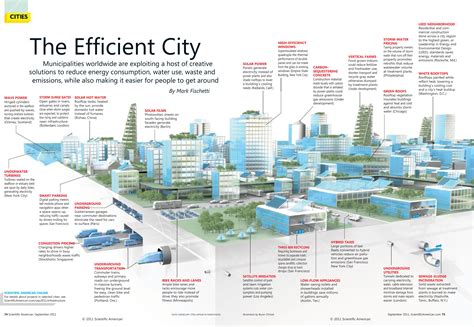In today’s rapidly urbanizing world, the concept of sustainable communities has become increasingly important. As our cities continue to grow, it’s crucial to consider how we can develop urban areas in a way that is both efficient and environmentally friendly. This is where urban planning comes into play, serving as the key to building sustainable communities. In this blog post, we’ll delve into the various aspects of urban planning that contribute to the development of sustainable communities. From assessing urban infrastructure to promoting mixed-use development and prioritizing affordable housing, we’ll explore the essential elements that make up sustainable urban planning. We’ll also discuss the role of green spaces, smart growth strategies, and sustainable transportation solutions in creating vibrant and efficient communities. Join us as we take a closer look at the ways in which urban planning can contribute to the creation of sustainable, livable, and thriving urban areas.
Table of Contents
Defining Urban Planning: A Key to Building Sustainable Communities
Urban planning is the process of designing and organizing the physical and social aspects of a community in order to create sustainable and vibrant urban spaces. Urban planning involves a wide range of factors, including land use, transportation, housing, and environmental sustainability. By considering these various elements, urban planners aim to create thriving communities that are both functional and enjoyable to live in.
The goal of urban planning is to promote sustainability by addressing current and future needs within a city or town. This can involve developing strategies for efficient land use, promoting public transportation to reduce traffic congestion and carbon emissions, and creating green spaces to enhance the quality of life for residents. By taking into account these various factors, urban planning plays a crucial role in fostering sustainable communities that can thrive for generations to come.
Urban planning also involves considerations of social equity and access to resources. Planners must strive to create communities that are accessible and inclusive for people from all walks of life. This may involve prioritizing affordable housing options, designing mixed-use developments that incorporate residential and commercial spaces, and ensuring access to public amenities and services for all residents. Ultimately, urban planning is about creating communities that are not only environmentally sustainable, but also socially and economically vibrant.
In conclusion, urban planning is a key component in building sustainable communities that can thrive in the long term. By carefully considering a wide range of factors, from land use and transportation to social equity and economic development, urban planners work to create spaces that are both functional and enjoyable for residents. The role of urban planning in sustainability cannot be understated, as it is crucial in shaping the future of our cities and towns.
Assessing Urban Infrastructure: The Foundation of Sustainable Communities
Urban infrastructure is the backbone of sustainable communities, providing essential resources and services to residents while also supporting economic growth and development. From transportation systems to water and energy networks, the quality and efficiency of infrastructure have a profound impact on the well-being of urban populations.
Assessing urban infrastructure involves evaluating its current state, identifying areas for improvement, and implementing solutions to address existing challenges. This process is critical for ensuring the long-term sustainability and resilience of cities, as well as for enhancing the overall quality of life for residents.
Infrastructure assessments can encompass a wide range of elements, including the condition of roads and bridges, the availability of public transportation, the reliability of electrical and water supply, and the accessibility of broadband internet. By analyzing these factors, urban planners and policymakers can make informed decisions about where and how to allocate resources for infrastructure maintenance and expansion.
Furthermore, assessing urban infrastructure involves considering the potential impact of new developments and population growth on existing systems. By proactively addressing the evolving needs of urban areas, cities can better prepare for future challenges and ensure that their infrastructure remains capable of supporting a thriving and sustainable community.
Promoting Mixed-Use Development: Creating Vibrant and Efficient Communities
Promoting mixed-use development is essential in creating vibrant and efficient communities. By integrating residential, commercial, and recreational spaces into a single area, mixed-use developments are able to foster a sense of community, reduce the need for long commutes, and create a more sustainable urban environment.
These developments not only promote a healthier and more active lifestyle by encouraging walking and cycling, but they also contribute to a more diverse and lively urban landscape. The combination of different land uses in one area allows for a more efficient use of space, reducing the need for extensive infrastructure and promoting a more visually appealing environment.
In addition, mixed-use developments have been shown to support local economies by providing a variety of employment opportunities and promoting local businesses. By creating a more walkable and accessible environment, these developments attract more people to the area, leading to increased economic activity and a stronger sense of community.
Overall, promoting mixed-use development is crucial in creating vibrant and efficient communities that are able to meet the diverse needs of urban residents while also supporting sustainability and economic growth.
Sustainable Transportation Solutions: Enhancing Mobility and Reducing Carbon Footprint
In today’s rapidly growing urban areas, the need for sustainable transportation solutions has never been more urgent. As cities continue to expand, the strain on existing transportation infrastructure is becoming increasingly evident, leading to traffic congestion, air pollution, and a higher carbon footprint. To address these challenges, it is essential to prioritize the development of sustainable mobility options that not only enhance the movement of people and goods but also reduce the overall impact on the environment.
One key strategy for achieving sustainable transportation is to promote the use of public transit systems. By investing in efficient and reliable public transportation networks, cities can provide residents with viable alternatives to personal vehicle usage, ultimately reducing traffic congestion and lowering emissions. Furthermore, the implementation of modern, energy-efficient vehicles and technologies within these transit systems can significantly contribute to the reduction of greenhouse gas emissions, helping to combat climate change and improve air quality.
In addition to public transit, the development of pedestrian and cycling infrastructure plays a crucial role in enhancing sustainable transportation options. Investing in well-designed bike lanes, pedestrian pathways, and urban greenways not only promotes physical activity and healthier lifestyles but also contributes to the reduction of carbon emissions by encouraging non-motorized modes of transportation. This approach can help create more walkable and bike-friendly urban environments, ultimately leading to a decrease in traffic congestion and a lower reliance on fossil fuel-powered vehicles.
Moreover, the integration of innovative technologies and smart mobility solutions can further enhance sustainable transportation in urban areas. From the use of electric and hybrid vehicles to the implementation of intelligent transportation systems, cities can leverage technological advancements to optimize traffic flow, improve accessibility, and reduce energy consumption. By embracing these cutting-edge solutions, urban planners and policymakers can create more efficient, equitable, and environmentally friendly transportation systems that benefit both current and future generations.
The Role of Green Spaces: Enhancing Quality of Life in Urban Areas
Green spaces play a crucial role in enhancing the quality of life in urban areas. These areas are vital for the physical and mental well-being of city residents, providing a peaceful escape from the hustle and bustle of urban life.
Furthermore, green spaces are essential for environmental sustainability, as they help to improve air quality, reduce the urban heat island effect, and support biodiversity.
People who have access to green spaces are more likely to engage in physical activities such as walking, jogging, and cycling, which in turn leads to a healthier lifestyle. In addition, these areas provide a sense of community and social interaction, as they serve as meeting points for residents from diverse backgrounds.
In conclusion, the presence of green spaces in urban areas is crucial for the well-being of residents and the overall sustainability of cities. Therefore, it is important for urban planners and policymakers to prioritize the preservation and creation of green spaces in order to enhance the quality of life in urban communities.
Smart Growth Strategies: Managing Urban Expansion Sustainably
Smart growth strategies refer to a set of urban planning principles that aim to manage urban expansion in a sustainable and efficient manner. These strategies focus on creating livable, walkable, and vibrant communities while preserving the environment and natural resources.
One key aspect of smart growth is the development of compact and mixed-use communities, which encourage a diverse range of housing options, promote economic development, and reduce the need for long commutes. By promoting urban infill and redevelopment, smart growth strategies strive to minimize the environmental impact of urban expansion and protect valuable green spaces.
In addition, smart growth initiatives prioritize the use of public transportation and active transportation modes such as walking and cycling. By investing in sustainable transportation solutions, cities can reduce traffic congestion, enhance air quality, and lower carbon emissions, contributing to a cleaner and healthier urban environment.
Overall, smart growth strategies play a crucial role in managing urban expansion sustainably, ensuring that cities can accommodate growth while maintaining a high quality of life for residents and minimizing their ecological footprint.
Prioritizing Affordable Housing: Addressing the Housing Crisis in Urban Communities
As urban populations continue to grow, the demand for affordable housing in urban communities has become increasingly urgent. The lack of affordable housing options has resulted in a housing crisis, with many individuals and families struggling to find suitable and affordable housing. Addressing this crisis is critical to ensuring the well-being and stability of urban communities.
Affordable housing is a key component of a sustainable and thriving urban environment. When individuals and families are burdened by high housing costs, it can have a ripple effect on their overall quality of life. Prioritizing affordable housing means ensuring that individuals and families have access to safe, decent, and affordable homes that are located within or in close proximity to urban areas, where opportunities for employment, education, and essential services are readily available.
Efforts to address the housing crisis in urban communities require a multi-faceted approach. This may involve working with developers and policymakers to incentivize the construction of affordable housing units, implementing policies and regulations to prevent gentrification and displacement of low-income residents, and investing in community land trusts and affordable housing initiatives.
By prioritizing affordable housing, urban communities can become more inclusive and equitable, offering opportunities for individuals and families from all walks of life to thrive and contribute to the vibrancy and diversity of the community. Addressing the housing crisis is not only a matter of providing shelter, but also a fundamental aspect of creating sustainable, resilient, and thriving urban environments.
Engaging Community Participation: Fostering Collaboration for Sustainable Development
Engaging community participation is crucial in fostering collaboration for sustainable development in urban areas. When community members are actively involved in the decision-making process, the resulting initiatives are more likely to reflect the needs and priorities of the people they are meant to serve. By empowering residents to participate in urban planning, local governments can ensure that policies and projects are in line with the community’s vision for the future.
One way to encourage community participation is by organizing town hall meetings and public forums where residents can voice their concerns and ideas. These gatherings provide a platform for engaging in meaningful dialogue and creating a sense of ownership over the development of their neighborhoods and cities. Additionally, online platforms and social media can be used to gather input from a wider audience, making it easier for a diverse range of voices to be heard.
Another important aspect of engaging community participation is collaborating with local organizations and stakeholders. By partnering with community groups, non-profits, and businesses, urban planners can tap into a wealth of knowledge and resources that can enrich the planning process. This collaboration can also lead to the implementation of more inclusive and sustainable solutions that are supported by the community.
Overall, prioritizing community participation and fostering collaboration is essential for ensuring that urban development initiatives are truly inclusive and sustainable. By listening to the voices of residents and working together with local stakeholders, cities can create vibrant and resilient communities that meet the needs of all their inhabitants.
Utilizing Technology in Urban Planning: Harnessing Innovation for Sustainable Solutions
When it comes to creating sustainable communities, the role of technology in urban planning cannot be overlooked. With the rapid advancements in technology, urban planners are now equipped with a wide range of tools and resources to drive sustainable solutions for urban development.
One of the key benefits of utilizing technology in urban planning is the ability to gather and analyze data more efficiently. Through the use of Geographic Information Systems (GIS), urban planners can now visualize and interpret data to make more informed decisions about land use, infrastructure development, and environmental conservation.
In addition, technology plays a crucial role in fostering community engagement and participation in the planning process. With the rise of social media and online platforms, urban planners can now interact with a wider audience, gather feedback, and involve the community in shaping the future of their neighborhoods.
Furthermore, harnessing innovation in technology allows for the implementation of smart city solutions, such as smart grids, intelligent transportation systems, and energy-efficient buildings. These technological advancements not only improve the quality of life in urban areas but also contribute to reducing carbon footprint and promoting sustainable practices.
Measuring Success: Evaluating the Impact of Urban Planning on Sustainability
Measuring the success of urban planning initiatives is essential for evaluating the impact of these efforts on creating sustainable communities. By assessing key performance indicators, such as energy efficiency, public transportation usage, green space accessibility, and affordable housing availability, urban planners can determine the effectiveness of their strategies in promoting sustainability.
Moreover, the long-term environmental, social, and economic impacts of urban planning decisions must be taken into account when measuring success. This includes evaluating the reduction of carbon footprint, improvement in air and water quality, community cohesion, and economic opportunities for all residents.
Utilizing data and technology in the evaluation process can provide valuable insights into the progress and areas for improvement in urban planning. Geographic information systems (GIS), satellite imagery, and smart city technology can help monitor and analyze urban development trends, environmental changes, and resource allocation, allowing for informed decision-making and adaptive planning strategies.
Ultimately, the success of urban planning can be measured by the extent to which these initiatives contribute to the long-term sustainability and resilience of communities, ensuring that current and future generations can thrive in a healthy and vibrant urban environment.





